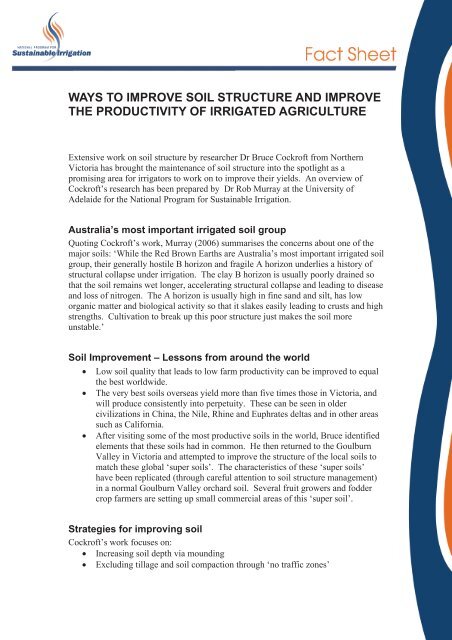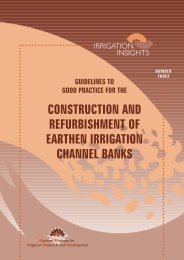ways to improve soil structure and improve the productivity of ...
ways to improve soil structure and improve the productivity of ...
ways to improve soil structure and improve the productivity of ...
Create successful ePaper yourself
Turn your PDF publications into a flip-book with our unique Google optimized e-Paper software.
WAYS TO IMPROVE SOIL STRUCTURE AND IMPROVE<br />
THE PRODUCTIVITY OF IRRIGATED AGRICULTURE<br />
Extensive work on <strong>soil</strong> <strong>structure</strong> by researcher Dr Bruce Cockr<strong>of</strong>t from Nor<strong>the</strong>rn<br />
Vic<strong>to</strong>ria has brought <strong>the</strong> maintenance <strong>of</strong> <strong>soil</strong> <strong>structure</strong> in<strong>to</strong> <strong>the</strong> spotlight as a<br />
promising area for irriga<strong>to</strong>rs <strong>to</strong> work on <strong>to</strong> <strong>improve</strong> <strong>the</strong>ir yields. An overview <strong>of</strong><br />
Cockr<strong>of</strong>t’s research has been prepared by Dr Rob Murray at <strong>the</strong> University <strong>of</strong><br />
Adelaide for <strong>the</strong> National Program for Sustainable Irrigation.<br />
Australia’s most important irrigated <strong>soil</strong> group<br />
Quoting Cockr<strong>of</strong>t’s work, Murray (2006) summarises <strong>the</strong> concerns about one <strong>of</strong> <strong>the</strong><br />
major <strong>soil</strong>s: ‘While <strong>the</strong> Red Brown Earths are Australia’s most important irrigated <strong>soil</strong><br />
group, <strong>the</strong>ir generally hostile B horizon <strong>and</strong> fragile A horizon underlies a his<strong>to</strong>ry <strong>of</strong><br />
structural collapse under irrigation. The clay B horizon is usually poorly drained so<br />
that <strong>the</strong> <strong>soil</strong> remains wet longer, accelerating structural collapse <strong>and</strong> leading <strong>to</strong> disease<br />
<strong>and</strong> loss <strong>of</strong> nitrogen. The A horizon is usually high in fine s<strong>and</strong> <strong>and</strong> silt, has low<br />
organic matter <strong>and</strong> biological activity so that it slakes easily leading <strong>to</strong> crusts <strong>and</strong> high<br />
strengths. Cultivation <strong>to</strong> break up this poor <strong>structure</strong> just makes <strong>the</strong> <strong>soil</strong> more<br />
unstable.’<br />
Soil Improvement – Lessons from around <strong>the</strong> world<br />
Low <strong>soil</strong> quality that leads <strong>to</strong> low farm <strong>productivity</strong> can be <strong>improve</strong>d <strong>to</strong> equal<br />
<strong>the</strong> best worldwide.<br />
The very best <strong>soil</strong>s overseas yield more than five times those in Vic<strong>to</strong>ria, <strong>and</strong><br />
will produce consistently in<strong>to</strong> perpetuity. These can be seen in older<br />
civilizations in China, <strong>the</strong> Nile, Rhine <strong>and</strong> Euphrates deltas <strong>and</strong> in o<strong>the</strong>r areas<br />
such as California.<br />
After visiting some <strong>of</strong> <strong>the</strong> most productive <strong>soil</strong>s in <strong>the</strong> world, Bruce identified<br />
elements that <strong>the</strong>se <strong>soil</strong>s had in common. He <strong>the</strong>n returned <strong>to</strong> <strong>the</strong> Goulburn<br />
Valley in Vic<strong>to</strong>ria <strong>and</strong> attempted <strong>to</strong> <strong>improve</strong> <strong>the</strong> <strong>structure</strong> <strong>of</strong> <strong>the</strong> local <strong>soil</strong>s <strong>to</strong><br />
match <strong>the</strong>se global ‘super <strong>soil</strong>s’. The characteristics <strong>of</strong> <strong>the</strong>se ‘super <strong>soil</strong>s’<br />
have been replicated (through careful attention <strong>to</strong> <strong>soil</strong> <strong>structure</strong> management)<br />
in a normal Goulburn Valley orchard <strong>soil</strong>. Several fruit growers <strong>and</strong> fodder<br />
crop farmers are setting up small commercial areas <strong>of</strong> this ‘super <strong>soil</strong>’.<br />
Strategies for improving <strong>soil</strong><br />
Cockr<strong>of</strong>t’s work focuses on:<br />
Increasing <strong>soil</strong> depth via mounding<br />
Excluding tillage <strong>and</strong> <strong>soil</strong> compaction through ‘no traffic zones’
Increasing root depth <strong>and</strong> <strong>the</strong> amount <strong>of</strong> roots by reducing <strong>the</strong> <strong>soil</strong>’s hardness<br />
<strong>and</strong> re-forming <strong>the</strong> <strong>soil</strong> in<strong>to</strong> aggregates <strong>of</strong> various sizes<br />
Increasing <strong>the</strong> porosity <strong>of</strong> <strong>the</strong> <strong>soil</strong> through <strong>the</strong> incorporation <strong>of</strong> organic matter<br />
Using mulches <strong>and</strong> rye grass in between tree rows <strong>to</strong> increase <strong>the</strong> volume <strong>of</strong><br />
roots in <strong>the</strong> <strong>soil</strong><br />
Avoiding rapid wetting or drying <strong>of</strong> <strong>the</strong> <strong>soil</strong> <strong>and</strong> ideally, keeping <strong>the</strong> <strong>soil</strong><br />
constantly moist <strong>to</strong> avoid <strong>the</strong> phenomenon <strong>of</strong> ‘coalescing’, where <strong>soil</strong><br />
aggregates (peds) gradually adhere <strong>to</strong> each o<strong>the</strong>r <strong>and</strong> <strong>the</strong> <strong>soil</strong> hardens <strong>and</strong> loses<br />
<strong>the</strong> variety <strong>of</strong> sizes that give it porosity <strong>and</strong> <strong>structure</strong>.<br />
The ‘super <strong>soil</strong>’ identified by Bruce Cockr<strong>of</strong>t requires <strong>the</strong> following practices <strong>to</strong> be<br />
developed <strong>and</strong> maintained. The most important are listed first. These are <strong>the</strong>n fur<strong>the</strong>r<br />
explained below.<br />
Practices <strong>to</strong> avoid<br />
Traffic compaction<br />
Clay contamination from <strong>the</strong> sub<strong>soil</strong><br />
Powdering (caused by cultivation when<br />
<strong>to</strong>o dry)<br />
Ex-cropping <strong>soil</strong><br />
Ex-pasture <strong>soil</strong><br />
Poor drainage<br />
Traffic compaction<br />
It is crucial that growers avoid any traffic on <strong>the</strong> beds.<br />
Clay contamination<br />
Deep ripping techniques <strong>to</strong> fracture <strong>the</strong> sub<strong>soil</strong> must be carefully employed <strong>to</strong> avoid<br />
lifting heavy clays up in<strong>to</strong> <strong>the</strong> A horizon.<br />
Powdering<br />
Excessive cultivation or cultivation when <strong>to</strong>o dry can destroy <strong>the</strong> most valuable<br />
physical characteristic <strong>of</strong> <strong>the</strong> <strong>soil</strong> – <strong>the</strong> aggregation <strong>of</strong> <strong>the</strong> <strong>soil</strong> particles in<strong>to</strong> ‘peds’ <strong>of</strong><br />
various sizes.<br />
Ex-cropping <strong>soil</strong><br />
Many conventional cropping practices deplete organic matter <strong>to</strong> less than 1%.<br />
Desirable organic matter levels might be as high as 6-7% <strong>to</strong> achieve ‘super <strong>soil</strong>s’.<br />
Accumulation <strong>of</strong> organic matter is an important precursor <strong>to</strong> achieving re-aggregation<br />
<strong>of</strong> <strong>the</strong> <strong>soil</strong>, through <strong>the</strong> action <strong>of</strong> root growth, fungal growth <strong>and</strong> colonisation by<br />
bacteria, worms <strong>and</strong> insects.<br />
Ex-pasture <strong>soil</strong><br />
Compaction by grazing animals makes <strong>the</strong>se <strong>soil</strong>s difficult <strong>to</strong> work with. Compaction<br />
primarily occurs when <strong>soil</strong>s are moist, but one brief compaction event can take years<br />
<strong>to</strong> undo. Cockr<strong>of</strong>t recommends that areas that have been grazed should be cropped<br />
with grasses <strong>and</strong> left uns<strong>to</strong>cked for at least 2 years <strong>to</strong> initiate <strong>the</strong> processes <strong>of</strong> res<strong>to</strong>ring<br />
<strong>the</strong> porosity <strong>of</strong> <strong>the</strong> <strong>soil</strong>.
Poor drainage<br />
Poor drainage leads <strong>to</strong> low oxygen levels in <strong>the</strong> <strong>soil</strong> which leads <strong>to</strong> low biological<br />
activity.<br />
Practices <strong>to</strong> use<br />
Rye grass<br />
Capillary irrigation<br />
Organic matter<br />
Reaggresizing<br />
Lime<br />
Rye grass<br />
Rye grass has prolific root growth <strong>and</strong> can assist in re-instating organic matter in <strong>the</strong><br />
<strong>soil</strong> <strong>and</strong> promoting biological activity that will assist in improving <strong>the</strong> <strong>soil</strong>’s physical<br />
<strong>structure</strong>.<br />
Capillary irrigation<br />
Flood <strong>and</strong> furrow irrigation have <strong>the</strong> effect <strong>of</strong> causing compaction <strong>and</strong> coalescence <strong>of</strong><br />
<strong>the</strong> <strong>soil</strong>. Capillary irrigation, where <strong>the</strong> water is drawn up <strong>to</strong> <strong>the</strong> roots from subsurface<br />
drip systems, helps <strong>to</strong> protect <strong>the</strong> <strong>soil</strong>.<br />
Organic matter<br />
In order for <strong>soil</strong> biota <strong>to</strong> thrive <strong>the</strong>y need a food source, which organic matter<br />
provides. Soil organic matter also helps <strong>to</strong> retain moisture in <strong>the</strong> root zone <strong>and</strong> make<br />
it available <strong>to</strong> <strong>the</strong> plant for longer.<br />
Re-aggresizing<br />
This process refers <strong>to</strong> a cultivation process which causes <strong>soil</strong> clusters, or peds, <strong>to</strong> reform<br />
in <strong>the</strong> <strong>soil</strong>, through a combination <strong>of</strong> root growth, increased organic matter <strong>and</strong><br />
increased biological activity.<br />
Lime<br />
For <strong>the</strong> red-brown earths <strong>the</strong>re is a common requirement <strong>to</strong> reduce <strong>the</strong> acidity <strong>of</strong> <strong>the</strong><br />
<strong>soil</strong>s, which makes plant nutrients more available <strong>and</strong> creates <strong>the</strong> chemical<br />
environment for increased biological activity.<br />
Conclusion<br />
With progress <strong>to</strong>wards this <strong>improve</strong>d <strong>soil</strong>, where <strong>the</strong> plant has ready access <strong>to</strong><br />
available <strong>soil</strong> water <strong>and</strong> nutrients, Cockr<strong>of</strong>t has estimated that <strong>the</strong> <strong>productivity</strong> <strong>of</strong><br />
Australian horticulture could be <strong>improve</strong>d 2-3 times its current levels. While his<br />
focus has been on perennial horticultural plantings, <strong>the</strong>re are many aspects <strong>of</strong> this<br />
work that are more widely applicable <strong>to</strong> agricultural <strong>soil</strong>s in general.
Fur<strong>the</strong>r reading<br />
Cockr<strong>of</strong>t, B. <strong>and</strong> Martin, F. M. (1981). Irrigation. In Red-Brown Earths <strong>of</strong> Australia.<br />
Edited by Oades, J. M., Lewis, D. G. <strong>and</strong> Norrish, K. Adelaide, Waite Agricultural<br />
Research Institute, University <strong>of</strong> Adelaide <strong>and</strong> CSIRO Division <strong>of</strong> Soils, S.A. p. 133-<br />
147.<br />
Cockr<strong>of</strong>t, B. <strong>and</strong> Olsson, K. A. (2000). Degradation <strong>of</strong> <strong>soil</strong> <strong>structure</strong> due <strong>to</strong><br />
coalescence <strong>of</strong> aggregates in no-till, no-traffic beds in irrigated crops. Australian<br />
Journal <strong>of</strong> Soil Research 38(1): 61-70. http://www.publish.csiro.au/paper/SR99079.htm<br />
Murray, R.S. (2006) A review <strong>of</strong> Dr Bruce Cockr<strong>of</strong>t’s work for Australian irrigated<br />
horticulture (in prep.). National Program for Sustainable Irrigation.
















